Choosing a flooring material may not be the first task that comes to mind when adding a hobby greenhouse to your landscape. However, flooring for these popular garden structures is much more important than you think. In this article, we’ll walk you through a few of the best greenhouse flooring options. We’ll also cover the basics of why flooring is so crucial when building and using a well-functioning greenhouse.
![Best Greenhouse DIY Flooring Options [Gardening 101]](https://wraxly.com/wp-content/uploads/2022/03/Best-Greenhouse-DIY-Flooring-Options-Gardening-101.webp)
4 of the Most Reliable Greenhouse Flooring Materials
There are plenty of materials that you can choose to use for your greenhouse floor. But some materials are far better suited to this role than others. Below are four of the best greenhouse flooring ideas for DIY’ers. You will also learn some important details about what it takes to implement each one.
Concrete
Our first greenhouse flooring option is both the most durable and potentially the most difficult to install. Concrete flooring provides a sturdy surface that will remain consistent for a long time and makes an excellent greenhouse foundation. It also provides an excellent surface on which you can walk and push wheelbarrows with ease.
For a DIY’er, installing a concrete floor can be a daunting task. One potential downside of using concrete is that it is not very forgiving. If you make a mistake while installing it, it can be difficult to fix.
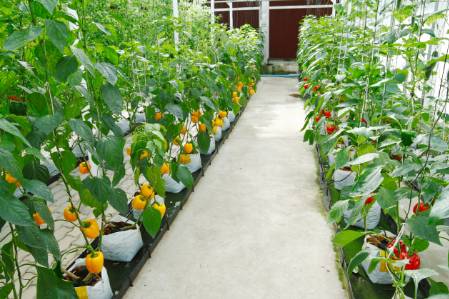
For most weekend gardeners, this is a project best left to the professionals. If you are not comfortable with a project of this size, it might be best to hire a contractor to pour the concrete slab for you.
Brick
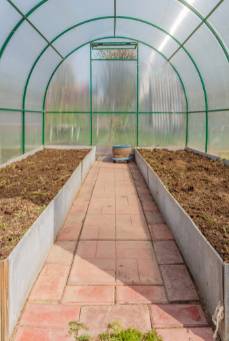
If you want to up the aesthetics of your greenhouse floor, then brick flooring is a popular choice and an option you should consider. Brick, and other types of dry-laid pavers, can come in a variety of colors and can lay in different patterns based on your preference.
Brick greenhouse flooring may not have the same degree of durability as concrete, but it is not far off. If you understand how to correctly create a level base with a layer of sand, your bricks should remain in place season after season.
Vinyl
Since greenhouses are as popular as ever, manufacturers have responded by creating numerous durable greenhouse flooring options. One of the best options is vinyl flooring. The advantage of vinyl flooring is that it is lightweight and relatively strong. Plus, it is easy for anyone to install on their own.
Some vinyl greenhouse flooring comes in a set of separate pieces, while others come in a roll. Either way, vinyl is a quick and easy flooring choice that can be surprisingly strong and often offers excellent drainage.

To prepare for installation, you will first need to lay down a wood subfloor over the bare ground. Use a minimum of 1/4″ thick plywood. This will help to create a level surface for your vinyl flooring. Additionally, this will also protect the vinyl from sharp rocks or other objects that could puncture it.
Once you have installed the plywood, you can then either roll out the vinyl or lay down the individual pieces.
Vinyl is an excellent choice for a greenhouse floor. It is inexpensive, easy to install, and can withstand a fair amount of abuse. However, it is not the most durable option and may need to be replaced after a few years of use.
FURTHER READING
- How to Build the Perfect Potting Shed
- Variegated Wax Plant Care: Everything You Need to Know
- Top 6 Best Garden Sprayers
- How to Treat Untreated Wood
Gravel
Our next option for greenhouse flooring is to use gravel. Using gravel as the floor of a greenhouse is one of the most cost-effective approaches. Unfortunately, it doesn’t make for the neatest finished product. Unlike concrete, brick, or vinyl, gravel floors will never be as smooth and can be a bit messier as well. They are a good option if you are on a budget, though.
Before you install a gravel floor for your greenhouse, you should begin by stripping any existing vegetation from the area. Then, dig down a few inches and cover the exposed soil with a weed barrier. You could also use a weed mat such as geotextile fabric to discourage future weeds from popping up. Once that fabric is in place, finishing your floor is as easy as pouring the gravel in, tamping it into place, and smoothing the surface.
No matter which flooring material you choose for your greenhouse, always take into account the climate and weather conditions in your area. In hot, dry climates, for example, concrete or brick may be a better choice as they are less likely to suffer from cracking or crumbling. Conversely, in colder climates, gravel or vinyl may be a better option as they will provide more insulation. By considering all of your options, you can be sure to find the best flooring for your greenhouse.
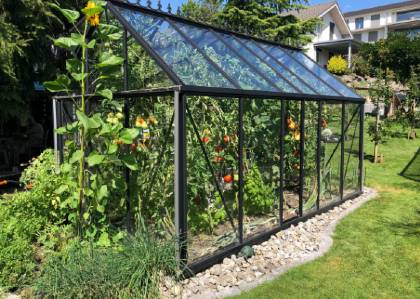
What Are the Advantages of Greenhouse Flooring?
Not only should you be aware of the best greenhouse flooring options, but you should also have a firm understanding of why flooring is so essential. The main benefits of proper greenhouse flooring are:
- A consistent walking surface: Hard flooring materials such as a poured concrete foundation provide a comfortable surface for walking. They are also consistent and predictable. This consistency makes it easy to walk on your greenhouse floor even while moving garden materials and tools. Overall, this quality allows for a smoother workflow while you tend to your greenhouse plants.
- Neatness and easy cleaning: The smoothness of a greenhouse floor makes it easy to sweep and clean. In the absence of a suitable floor, you’ll find dirt and other filth often accumulating in your greenhouse. With a greenhouse floor that is easy to clean, you will spend less time tidying your workspace. This means more time attending to your plants.
- Minimal weeds and plant debris: One of the most annoying aspects of having a greenhouse without a floor is that you’ll probably find plenty of pesky weeds growing inside each year. The presence of these weeds makes it more difficult to keep your greenhouse clean and in good working order. A greenhouse flooring material will act as a dependable barrier, preventing weed growth from intruding upon your greenhouse.
- Efficient drainage: As is the case with anything you build on your land, greenhouses need good drainage. And the floor you install has a lot to do with how excess water drains from within your greenhouse. Some flooring options, like gravel or dry-laid brick, are porous enough to allow water to drain quickly. But even non-porous flooring, like concrete, should drain well too. A drainage system for non-porous flooring can be as simple as a subtle but specific pitch that sheds water in a specific direction. If your greenhouse has no floor, you’ll have little to no control over the puddles that form inside.
- Better overall appearance: Lastly, flooring gives your greenhouse a more finished look. At times, the flooring you choose may even enhance an overall aesthetic goal. While appearances may not be the top priority of building a greenhouse, if you want yours to look its best, you’ll need to include some attractive flooring materials.
As you can now see, there are at least five compelling reasons why a greenhouse floor is worth the investment. However, many gardeners remain tempted to try and build a greenhouse without any floor at all. In the next section, we’ll explore how viable this option really is.
Recommended Weed Barriers
| Image | Title | Prime | Buy |
|---|---|---|---|
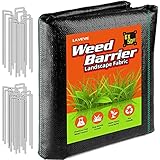 | LAVEVE 6FT x 50FT Weed Barrier Landscape Fabric, 3.2oz Premium Heavy-Duty Gardening Weed Control Mat, Ground Cover for Gardening, Farming with 20 U-Shaped Securing Pegs | PrimeEligible | Check Price on Amazon |
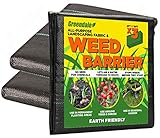 | Greendale - 3 Pack of Premium 4 ft x 10 ft Sheets (Heavy Duty 5 oz Fabric) - Landscape Weed Barrier (120 Square Feet of Total Coverage) Your Landscaping and Garden Needs | PrimeEligible | Check Price on Amazon |
Top | WAENLIR 5.8oz 20 Year Heavy Duty Weed Barrier Landscape Fabric,Premium Durable Weed Blocker Cover,Outdoor Gardening Weed Control Mat 3ft x100ft | PrimeEligible | Check Price on Amazon |
 | VIVOSUN 5oz/sy Barrier Landscape Fabric 3 ft. x 50 ft, Commercial Ground Cover Fabric Block, Gardening Fabric Mat, Black Heavy Duty Garden Cloth Felt for Flower Bed, Patio, Orchard, and Playground | PrimeEligible | Check Price on Amazon |
 | Dewitt SBLT3300 Sunbelt Ground Cover Weed Barrier, 3 x 300-Feet,Black | Prime | Check Price on Amazon |
 | HOOPLE Garden Weed Barrier Landscape Fabric, Heavy Duty & Ultra Thick, Premium Weeds Control for Flower Bed, Pavers and Other Outdoor Projects. Easy Setup & Convenient Design, Black (32inch X 180ft) | PrimeEligible | Check Price on Amazon |
Can You Have a Greenhouse without Flooring?
It’s possible to have a greenhouse with just a soil flooring. However, you will miss out on some, if not all, of the distinct advantages that greenhouse flooring provides. Still, floor-less greenhouses are not entirely unreasonable. If you take this route, you need to know how to do so correctly and then decide if it’s the best choice.
Having a greenhouse with dirt floors does not mean that you can simply place your greenhouse’s main structure anywhere you like on the ground. Instead, you’ll need to prepare the ground before you install the rest of your greenhouse.
HANDPICKED RELATED CONTENT: Get instant access to 12,000 shed plans HERE!
To create a floorless greenhouse, you should begin by finding a flat surface and removing all existing vegetation from the floor area. After, you should use a tamper to compact the remaining soil. In most cases, soil compaction is not beneficial to gardening. However, in this case, compacting the soil will not only make it more difficult for unwanted weeds to sprout up in the future but will also make for a smoother walking surface.
If you choose to have a greenhouse with no floor, expect to find at least some weeds growing each year. To help with this, laying down a weed cloth, landscape fabric, or greenhouse flooring fabric can be an option. You’ll also find that a floorless greenhouse is much less neat. Expect to track soil in and out of your greenhouse while you work.
Final Thoughts
Admittedly, choosing a floor is not the most exciting aspect of building a greenhouse. With that said, flooring is not something you can ignore. The type of floor you choose for a greenhouse influences how easy your greenhouse is to use, clean, and much more. Be sure to refer to the information above to help you figure out the right choice the next time you need to decide on the best greenhouse flooring option for you.

John Haryasz is a freelance writer and landscape designer. In the field of landscape architecture, he has contributed to many successful design projects throughout the country. As a writer, John specializes in creating captivating and informative web content. Through that work, he aims to share his design knowledge and promote engagement with the outdoor world.



![A Simple DIY Method to Create a Backyard Koi Pond [Gardening 101]](https://wraxly.com/wp-content/uploads/2022/05/A-Simple-DIY-Method-to-Create-a-Backyard-Koi-Pond-Gardening-101-1200-×-675-px-1024x576.webp)